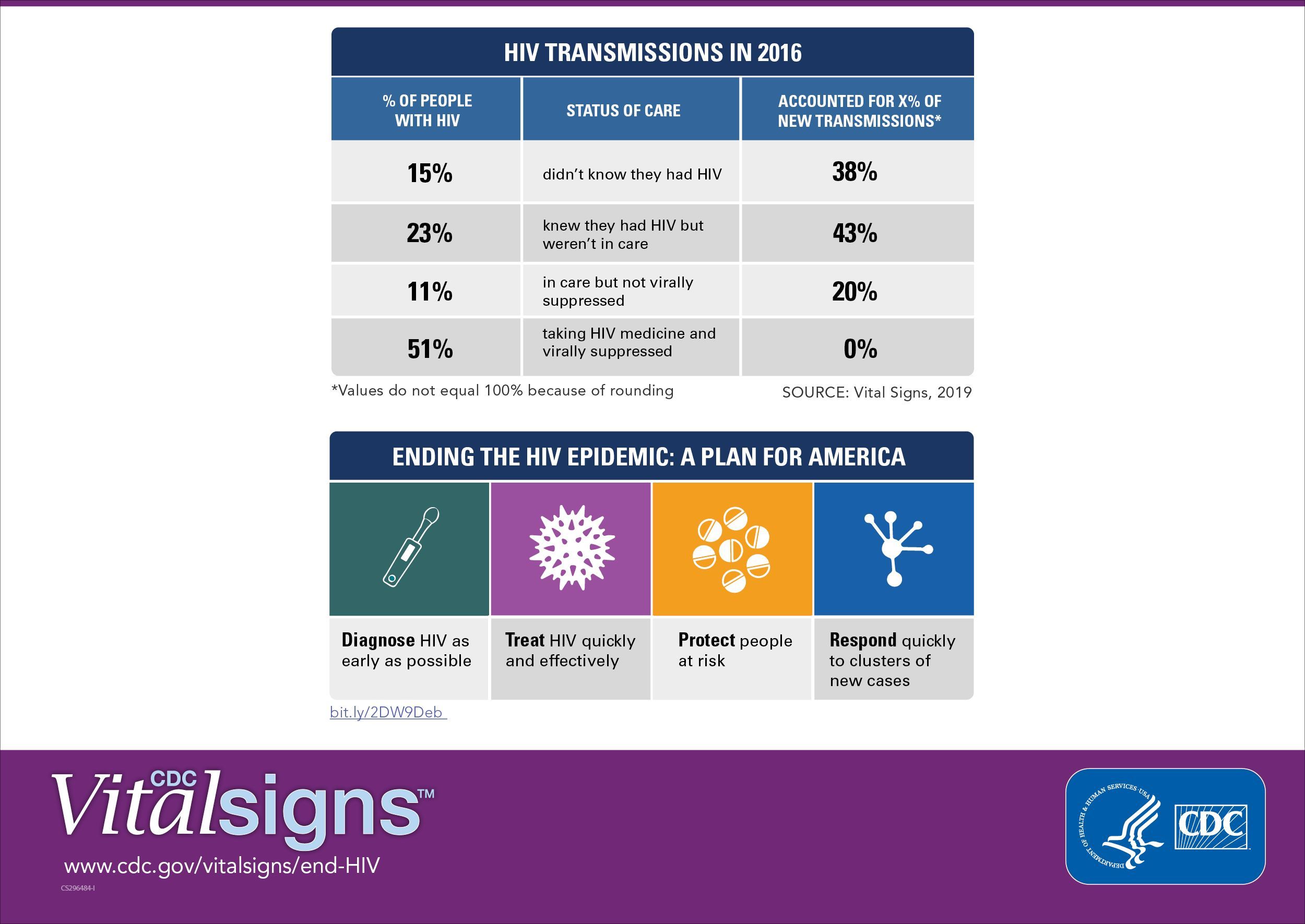Gaps in HIV Testing and Treatment Hinder Efforts to Stop New Infections

The vast majority (about 80 percent) of new HIV infections in the U.S. in 2016 were transmitted from the nearly 40 percent of people with HIV who either did not know they had HIV, or who received a diagnosis but were not receiving HIV care.
Published on the first day of CDC’s 2019 National HIV Prevention Conference, a new CDC Vital Signs report provides the latest data on the impact of undiagnosed and untreated HIV in the nation and underscores the critical need to expand HIV testing and treatment in the U.S.
Getting more people tested and in HIV care is a critical part of the proposed federal initiative, “Ending the HIV Epidemic â A Plan for America.” The initiative’s goal is to end the HIV epidemic over 10 years by focusing first on the geographic areas with the greatest HIV burden, before expanding to reach all areas of the nation affected by HIV.
“We have an unprecedented opportunity to end the HIV epidemic in America,” said assistant secretary for health at the U.S. Department of Health and Human Services, Admiral Brett P. Giroir, MD. “We must close these glaring gaps in HIV prevention and care, and we must start now.”
The proposed initiative is designed to rapidly increase use of these strategies in the 48 counties with the highest HIV burden, as well as in Washington, D.C.; San Juan, Puerto Rico; and seven states with a disproportionate rural HIV burden. The goal is to reduce new HIV infections by at least 90 percent over 10 years.
Efforts would begin with a proposed $291 million in the FY2020 HHS budget to provide the hardest-hit communities with the additional expertise, technology, and resources required to address the HIV epidemic in their communities.
“Diagnose, treat, protect, and respond: These are the key strategies in our historic initiative to end the HIV epidemic in America by engaging all the people at risk into comprehensive prevention strategies,” said CDC director Robert R. Redfield, MD. “These new Vital Signs data show the tremendous impact we can have by helping all Americans living with HIV know their diagnosis, quickly get into treatment, and remain in care to stay healthy.”
According to the study findings, about 80 percent of new HIV transmissions are linked to people whose HIV is either undiagnosed or currently untreated. CDC recommends that once a person with HIV learns their status, they begin taking antiretroviral therapy, or ART.
When taken as directed, ART reduces the amount of HIV in the body to a very low level -also known as viral suppression. Studies indicate that people who are virally suppressed can protect their own health and have effectively no risk of transmitting HIV to others through sex, as long as they stay virally suppressed.
The findings of the analysis highlight:
• A need to increase the proportion of people who are aware of their HIV status. The nearly 15 percent of people with HIV whose infections are undiagnosed, account for almost 40 percent of all HIV transmissions.
• It’s critical to help those with HIV get care. The roughly 23 percent of people with HIV whose infections are diagnosed, but they are not receiving HIV care, account for 43 percent of all HIV transmissions.
• The importance of helping people with HIV take medicine and maintain viral suppression. The 11 percent of people with HIV who were receiving care, but were not virally suppressed, account for 20 percent of all HIV transmissions.
“Today, we have the tools to end the HIV epidemic,” said Jonathan Mermin, MD, director of CDC’s National Center for HIV/AIDS, Viral Hepatitis, STD, and TB Prevention. “But a tool is only useful if it’s in someone’s hands. This is why it’s vital to bring testing and treatment to everyone with HIV â and to empower them to take control of their lives and change the course of the epidemic.”
CDC scientists used a model to estimate HIV transmission in 2016 along the HIV continuum of care. Model inputs on HIV prevalence, incidence, receipt of care, and viral suppression came from the National HIV Surveillance System data, and inputs on HIV risk behaviors came from National HIV Behavioral Surveillance data.
What can everyone do to stop new HIV infections?
• Know your HIV status and how to prevent HIV.
• Support family and friends who have HIV: www.cdc.gov/together
• If you are living with HIV, start HIV care immediately (or as soon as possible), stay in care, and take medicine as prescribed.
• Use prevention tools such as condoms and pre-exposure prophylaxis (PrEP) to prevent transmission of HIV if at risk of acquiring HIV: www.cdc.gov/hiv/risk
CDC’s efforts to increase testing and treatment for people with HIV
CDC works with national, state, and local partners to:
• Increase HIV testing.
• Link people with HIV to care and help them remain in care.
• Track HIV trends so that federal and state resources are quickly directed to the most affected populations and to the areas with the greatest need.
To read the entire Vital Signs report, visit: www.cdc.gov/vitalsigns/end-HIV. For more information about the federal initiative to end the HIV epidemic in the United States, visit: https://www.hiv.gov/ending-hiv-epidemic?s_cid=ht_endinghivinternet0001.
Source: U.S. Department of Health and Human Services